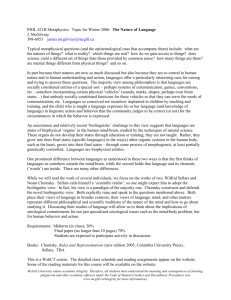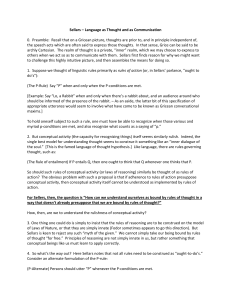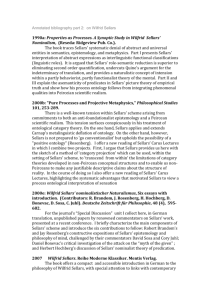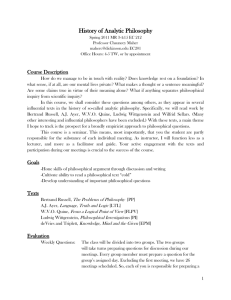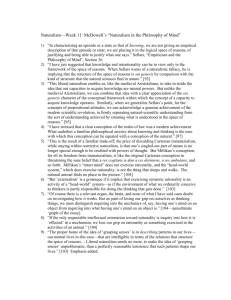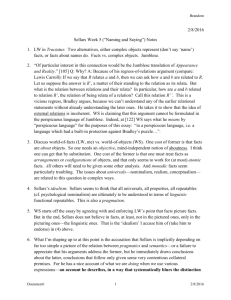S_miller_saap_2011_p..
advertisement
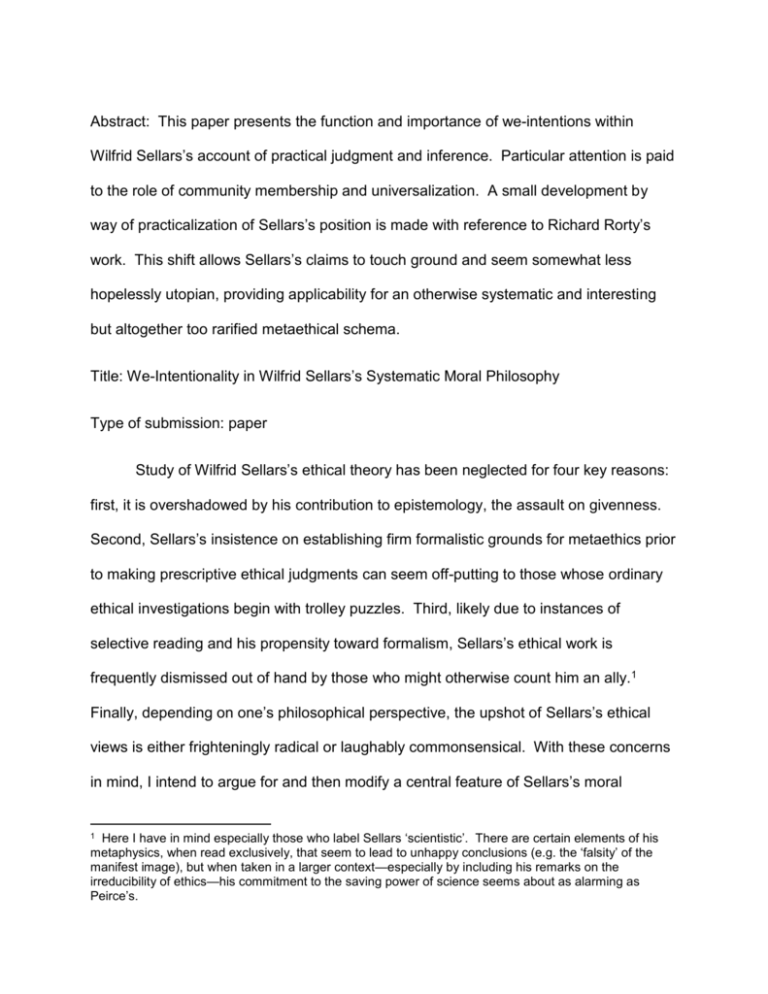
Abstract: This paper presents the function and importance of we-intentions within Wilfrid Sellars’s account of practical judgment and inference. Particular attention is paid to the role of community membership and universalization. A small development by way of practicalization of Sellars’s position is made with reference to Richard Rorty’s work. This shift allows Sellars’s claims to touch ground and seem somewhat less hopelessly utopian, providing applicability for an otherwise systematic and interesting but altogether too rarified metaethical schema. Title: We-Intentionality in Wilfrid Sellars’s Systematic Moral Philosophy Type of submission: paper Study of Wilfrid Sellars’s ethical theory has been neglected for four key reasons: first, it is overshadowed by his contribution to epistemology, the assault on givenness. Second, Sellars’s insistence on establishing firm formalistic grounds for metaethics prior to making prescriptive ethical judgments can seem off-putting to those whose ordinary ethical investigations begin with trolley puzzles. Third, likely due to instances of selective reading and his propensity toward formalism, Sellars’s ethical work is frequently dismissed out of hand by those who might otherwise count him an ally.1 Finally, depending on one’s philosophical perspective, the upshot of Sellars’s ethical views is either frighteningly radical or laughably commonsensical. With these concerns in mind, I intend to argue for and then modify a central feature of Sellars’s moral Here I have in mind especially those who label Sellars ‘scientistic’. There are certain elements of his metaphysics, when read exclusively, that seem to lead to unhappy conclusions (e.g. the ‘falsity’ of the manifest image), but when taken in a larger context—especially by including his remarks on the irreducibility of ethics—his commitment to the saving power of science seems about as alarming as Peirce’s. 1 philosophy—the role of communal intentions—while simultaneously softening or presenting more positively some of those aspects of his work which might otherwise seem disagreeable or alarming. Unlike many contemporary thinkers of his tradition, Sellars’s philosophy is systematic and yet hangs together strikingly well. Because of this, his writings on one subject often contain references to his thoughts about another; a seemingly unrelated but included passage frequently functions as a breadcrumb trail, tempting the reader to move beyond the narrow aim that led him or her to read a particular article. One of the most conspicuous examples of this is found at the tail-end of “Philosophy and the Scientific Image of Man,” in which Sellars traced the relationship between scientific and non-scientific descriptions of reality before declaring the latter to be, at base, false. The unchecked, totalizing character of this claim was most explicitly laid out some years later as “in the dimension of describing and explaining the world, science is the measure of all things, of what is that it is, and of what is not that it is not.”2 It then comes as something of a surprise when he commented in passing that when one claims that “a certain person desired to do A, thought it his duty to do B but was forced to do C … one does something more [than description]. And it is this something more which is the irreducible core of the framework of persons.”3 Despite his deference to scientific description, some element of what it is to be a person—or amongst the framework of persons—is admitted to be irreducible4 and therefore, on Sellars’s account, requires 2 Wilfrid Sellars, Empiricism and the Philosophy of Mind, (Cambridge: Harvard University Press, 1997), IX.42. 3 Wilfrid Sellars, “Philosophy and the Scientific Image of Man,” in In the Space of Reasons, Kevin Scharp & Robert Brandom, eds (Cambridge: Harvard University Press, 2007), 407. 4 Sellars is not claiming that any element of reality eludes scientific description; rather, as will be seen, he suggests one cannot look to science to offer a complete explanation by way of description. 2 nonscientific, explicitly philosophical investigation. It is notable that the particular elements he identified as irreducible to scientific description are those of desire and duty—that is, they are among the normative. Sellars leveraged two features of normative discourse in order to emphasize its independence from the eliminative description of scientific reduction. Neither of these features is particularly shocking on its own, but when taken together, they allowed Sellars to introduce a novel metaethical schema. The first constituent is that, as with other elements of practical philosophy, ethical statements and beliefs are not inert: real belief cashes out in real consequences or, as Peirce claimed, “belief consists mainly in being deliberately prepared to adopt the formula believed as a guide to action.”5 Speaking generally, “Sellars [wa]s concerned … to identify moral judgments as one form of practical judgment and to explore the relationship between them and other practical judgments.” 6 The reason for this seems plain enough: in normative discourse, an individual who accepts one judgment frequently commits him or herself to another, which may entail some action taking place. An example of this may be seen in an individual simultaneously believing “I want my children to go to college” and “For my children to go to college, I will have to pay for their tuition.” By having both of these beliefs simultaneously, the individual is required to do what he or she can to engage in an action, namely tuition-paying. But there is more to this chain of reasoning than just these two statements; there are enthymematic linking terms that play into this sort of Charles S. Peirce, “The Meaning of ‘Practical’ Consequences,” CP 5.27. W. David Solomon, “Ethical Theory,” in Synoptic Vision: Essays on the Philosophy of Wilfrid Sellars (Notre Dame, IN: University of Notre Dame Press, 1977), 155. 5 6 3 decision-making. Beginning with but one or two practical judgments can frequently set off a long series of further judgments, all of which eventually lead to consequent action. Many traditional accounts of practical philosophy in general and ethics in particular have been content to claim that judgments of this kind are best rendered in the imperative mood; for instance, the prescriptive character of normativity has frequently been cashed out as ‘thou shalt’ this or that. Sellars was convinced that any account of imperative inference cannot fully express the entailment-relationship of these judgments, so he requires that they instead be treated as nonimperatives.7 His way of doing this was to recast such judgments as intentions,8 which are always in the indicative mood. If all normative judgments are understood with this modality, they can be used as elements of indicative inference, which preserves the explanatory efficacy of a practical-reasoning account of moral decision-making. For Sellars, indicativevolitional statements functioned simultaneously as intentions, reasons, and causal antecedents of action, which is precisely what is desired when one makes a moral judgment. The second interesting and essential feature of ethical discourse that set Sellars’s project in motion is that it occurs only in communities—and more importantly, that we feel a sense of contradiction when our norms disagree with those of our peers. One of the major difficulties that arise when one fails to account for the communal nature of ethical judgments is found in questions of intersubjectivity. For instance, one speaker might think the United States should be at war while another thinks quite the 7 It is in this way the Sellarsian system avoids emotivism. Quite a lot more could be said about where Sellars’s work fits into the history of analytic metaethics; for the moment, it is enough to note he was attempting to put flesh on the bare bones of Prichard's insights (cf. Solomon, 155). 8 For the sake of brevity, I will not be covering the novel and difficult ‘shall-operator’. 4 opposite. Each of these two likely believes in the exclusivity of his or her judgment; from speaker A’s position, speaker B is wrong, and the same is surely the case for speaker A’s position in the opinion of speaker B. If either of these positions were understood as nothing more than individual ethical expressions, there could never be normative contradictions, for “I believe the United States should be at war,” said by Speaker A seems to be contradicted by either “It is not the case that Speaker A believes the United States should be at war” or an additional utterance by Speaker A, “I believe the United States should not be at war.” But neither of these proposed contradictions is acceptable: the first is a negation of ascription instead of a negation of intention, while the second is an entirely different positive intention.9 Even if these forms were to contradict, it is notable that no statement at all made by speaker B could in principle contradict those of speaker A. The intentions, dispositions, and judgments of B may certainly disagree with those of A, but if Sellars’s normative-intentional scheme is correct, they may never individually be brought into contradiction. Realizing this deficiency, there seem to be three ways one can respond. The first is to reject intentionality as the basic category of practical reasoning. This would be to return to a purely doxastic format, perhaps with an attempt to develop a system of reasoning inclusive of statements in the imperative mood. In accepting this kind of response, however, one must confront a difficulty in explaining how agents move into and then back out of the processes of reasoning. Sellars’s system is attractive in that A third potential formulation, “It is not the case that I believe the United States should be at war,” uttered by the same speaker A, does contradict “I believe the United States should be at war,” but it cannot be cashed out as an intention in the same way any of the other pseudo-contradictions may for reasons related to the (here intentionally neglected) shall-operator. 9 5 one can begin with the facts of the world, enter language and deliberation, and then return to the world through action. A second potential reply is to deny either the reasonability of ethical discourse or that normative contradiction occurs. Depending on the specifics of this response, one endorses either Ayerian emotivism or some form of ethical egoism. While these positions may be satisfying to some, Sellars rejected them out of hand, writing in rejection of emotivism: “it struck me as wrongheaded in its early insistence on the pseudo-conceptual character of ethical terms, propositions, and reasonings.”10 The third possible response to the problem of contradiction in intentional accounts of normativity is to reconstruct intentionality so that there is more to moral discourse than only the individual interlocutors’ intentions. This is precisely the tack Sellars takes, recognizing that in order to maintain the universality he desired while simultaneously keeping ethical beliefs as action-motivating thoughts, he had to posit “We-Expressions of Intention.”11 These are expressions of intention that “express the intention of a group but are asserted (or expressed) by members of a group.”12 So, when speakers A and B genuinely disagree about whether the United States should be at war, they are not each merely expressing their own respective I-intention but rather making a claim about the desirability of the aims of one of the groups to which they both belong. So while speaker A and B might each assert “I intend that the United States will (and will not) be at war,” insofar as they are making a normative claim, there Willem deVries, Wilfrid Sellars (Montreal: McGill-Queen’s University Press, 2005), 310. Wilfrid Sellars, Science and Metaphysics: Variations on Kantian Themes (New York: Routledge & Kegan Paul Ltd, 1968), 215. 12 W. David Solomon, op. cit., 175. 10 11 6 is a deeper form underlying their utterances. This underlying position is expressed in the form “We intend the United States will (and will not) be at war,” though neither of the disagreeing speakers explicitly says this. This formal referent—the objects of which are interrelated, intersubjective, and shared—preserves the possibility of genuine and direct deliberative contradiction. We-intentions thus solve a problem that remained apparent in any individualistically intentional account of practical judgment. Sellars showed how intuitive this understanding is, given that the question “What ought I to do in these circumstances (from the moral point of view)?” is tightly related to the questions “What would we [intend] that I do in these circumstances?” and “What would we [intend] that any of us do in these circumstances?”13 To engage a question from the moral point of view is to attempt to engage a more-universal perspective—the perspective of one’s community. This recognition, however, says very little about what we-intentions are, a difficulty noticed by commentators. David Solomon explains, “It is remarkable … that Sellars spends so little time defending or explaining his notion of we-intentions, since they play a crucial role in his overall account of moral judgments.”14 Nonetheless, a number of aspects of we-intentions may be elucidated, and from these something more will be apparent than just their necessity in preserving the possibility of contradiction. Sellars was clear that we-intentions are not just conjunctions of individual intentions. While Jones and Smith might each share a certain judgment and intention, their individual assertions taken together do not account for the features of weWilfrid Sellars, “‘Ought’ and Moral Principles,” unpublished manuscript dated “Pittsburgh, February 14, 1966,” available online http://www.ditext.com/sellars/omp.html. 14 W. David Solomon, op. cit., 175. 13 7 intentions Sellars needed to make morality truly robust. Likewise, we-intentions cannot be an individual intention attached to a belief that others in one’s community hold a similar position. This fails on two accounts: Sellars was clear that I-intending and weintending are different forms of intention,15 and more significantly, “we-intending involves a special ‘form of consciousness’ … [or] ‘form of life’.”16 This latter criterion is undeniably provocative, especially insofar as it directly sheds light on how Sellars took communities to be something more than simply the sum of their constitutive members. It is fair to say that this “something more” is what makes Sellars’s brand of scientific realism appealing to one who might wish to preserve the essential reality of the most important elements of the lived world in the face of an otherwise reductionistic account. The ‘irreducibility’ mentioned at the end of “Philosophy and the Scientific Image of Man” is in no way referring to an exception to the project of science’s metaphysical supremacy Sellars defended in that article and throughout his career. Instead, Sellars was making a fundamentally interesting point of which much has been made in the nonanalytic philosophical traditions: valuing is an inherently community-bound affair. In the realm of normativity, it is impossible to regard we-intentions as individual intentions, because there are no individual intentions without there first being communal life; with moral judgments, one cannot I-intend until he or she participates in we-intending. To engage in ethical discourse from a purely individual point of view is to miss the point of ethics and perhaps even to embrace absurdity. 15 16 Wilfrid Sellars, “Imperatives, Intentions, and the Logic of ‘Ought’,” in Methodos, Vol. 8 (1956): 203. W. David Solomon, op. cit., 176. 8 It is likewise absurd to expect that any straightforwardly static and purely physical description of an object could reduce it without remainder to the language of science in general and particle physics in particular. It is exactly here that Sellars’s scientific realism took a drastic turn from that of his contemporaries. There is little doubt that part of a description of any item or situation will involve reference to the coordination and interaction of microphysical particles, but can notions as abstract as ought-to-be or ought-to-do be handled in just this way? “Any attempt to capture [these notions] in the language of microphysics alone would be at best wildly disjunctive, and even so, it would be inaccurate.”17 Hunting in this way for the ‘true account’ of something as complex as communally-based normativity is at base wrongheaded. Intending in this new mode or form of life, intending within a group is the very form of moral discourse.18 Due to his use of we-intentions, the particular moral judgments of an individual are inherently linked in virtue of explanation to those of the individual’s particular group-affiliations. Taking seriously one’s participation in a group and the connection between individual actions and the success of group-goals (as expressed in we-intentions) of course reemphasizes the necessary degree of universalization Sellars suggested. If one’s individual behavior would better achieve group intentions, and if moral discourse is nothing over and above group-intending, then one’s moral intentions necessarily require that anyone in a relevantly similar position behave in accordance with individual intentions. Better said, any member of a group who believes his or her behavior would 17 18 Willem A. deVries, op. cit., 275. Wilfrid Sellars, op. cit., 204. 9 help to reach a group intention must believe any other member of the group should behave identically, and for the same reasons. This is a necessary consequence of Sellars’s understanding of ethical intending occurring in the scope of communities: were we-intendings only conjunctions of individual intentions, this would not be so. Sellars recognized that this understanding of intentionality endangered the distinction between duty to oneself and duty to all others, and failed to give specific content to morality. To begin to fill these gaps, he posited benevolence as the ultimate moral end.19 This he took to be “not the impartial love of everybody … but the simple recognition of people generally as we.”20 Benevolence is then a commitment to the general welfare, based in acknowledgement of community-consciousness: “It is a … fact that people constitute a community, a we, by virtue of thinking of each other as one of us, and by willing the common good … as one of us, or from a moral point of view.”21 Sellars therefore constructed a certain sense of benevolence that is in play only when one recognizes others as members of one’s own community and from this standpoint enters into moral discourse of the form ‘we intend’. But how wide should the scope of the ‘we’ be understood? In a decidedly Kantian moment, Sellars admits that the aim of moral reasoning is to include all rational beings; the moral ‘we’ “has no explicit membership rider: it is not ‘we educators’, ‘we Democrats’, or even ‘we human beings’.”22 Despite the unlikelihood of presenting argumentation that shores up the necessary conditions for the fully-encompassing ethical community, Sellars argued that “we do care and are raised to care about the 19 Ibid., 209. Ibid., 210. 21 Wilfrid Sellars, Science and Metaphysics: Variations on Kantian Themes, 222. 22 Willem A. deVries, op. cit., 285-6. 20 10 well-being of at least some of our fellow beings.”23 Given his earlier presentation of benevolence as the ultimate moral principle—a principle he equates with Royce’s Loyalty and Christian Love—Sellars showed how seriously he took moral development: the commitment to the well-being of others is a commitment deeper than any commitment to abstract principle. It is this commitment to the wellbeing of our fellow man which stands to the justification of moral principles as the purpose of acquiring the ability to explain and predict stands to the justification of scientific theories.24 Most of Sellars’s ethical writings were concerned to describe the formal process whereby moral reasoning occurs. Nonetheless, the statement that other people matter more than abstract principles is a potential link to Hegel and functions as a strong emphasis of Sellars’s commitment to the importance of moral fellow-feeling. Eschewing a membership rider on the ideal we presents practical difficulties. Requiring a fully-universalized ‘we’ prior to any instance of normativity comes off as overly utopian and counterproductive. No matter how often and loudly it may be said that we are all in this together and thus must hang together or separately, many are resistant to this universal vision of humanity and throw their hands up in frustration, succumbing to radical egoism. With this in mind, that “the best can be an enemy of the better,”25 certain thinkers have insisted that an appropriate use of Sellars’s vision is to 23 W. David Solomon, op. cit., 267. Wilfrid Sellars, “‘Ought’ and Moral Principles,” unpublished manuscript dated “Pittsburgh, February 14, 1966,” available online http://www.ditext.com/sellars/omp.html. 25 Rorty, Richard. “The Best Can be an Enemy of the Better,” in Take Care of Freedom and Truth Will Take Care of Itself, Eduardo Mendieta, ed. (Palo Alto, CA: Stanford University Press, 2005), 105. 24 11 maintain his moral end of benevolence but also make explicit a membership rider that has in fact always been implicit in ‘groupiness’ accounts of morality like his. One of the few contemporary thinkers to identify his moral position as directly descended from Sellars’s is Richard Rorty, a point he made in most detail in Contingency, irony, and solidarity. From Rorty’s exploration of Sellars’s position, important insights may be gained. For instance, when one makes moral judgments from the perspective of a ‘we’, he or she is being a kind of ethnocentrist. This, on Rorty’s view, is no cause for alarm, for it is here that ‘we’ is given its membership criterion explicitly, when Rorty wrote of “we liberals,” with ‘liberal’ being understood as those for whom cruelty is the worst thing in the world. The sense of benevolence upon which Sellars relied is inextricably linked to a limitation of cruelty-induced suffering. Sellars’s ethnocentrism “is … [that] of a ‘we’ which is dedicated to enlarging itself”26 and to limiting cruelty. By continually expanding the scope of “one of us” and minimizing cruelty, there need be no fear that this ethnocentrism cashes out destructively, for “it is thought of as the ability to see more and more traditional differences—of tribe, religion, race, customs, and the like—as unimportant when compared with similarities with respect to pain and humiliation—the ability to think of people wildly different from ourselves as included in the range of us.”27 By understanding ethics as involved in questions of intentions rather than prohibitions, and communal strivings instead of individual desires, Sellars prepared an account that does justice to both the logic and experience of normativity. But despite 26 27 Rorty, Richard. Contingency, irony, and solidarity. (New York: Cambridge University Press, 1989), 198. Ibid., 192. 12 having all of this worked out, he was unwilling to let his theorizing touch ground except to admit that other people must be of greater importance than maxims and theories. Happily, Rorty provided a further practicalization of Sellars’s thinking, including a criterion by which our success in being benevolent may be measured. The ultimate ‘we’—the ‘we’ to which Sellars and Rorty strove—is that of either all reasoners or sufferers, but the impossibility of attaining this should not be a roadblock for the good we can do, most of all by finding ways to limit our experienced cruelty. 13
